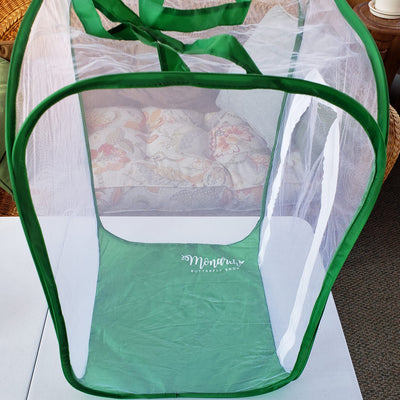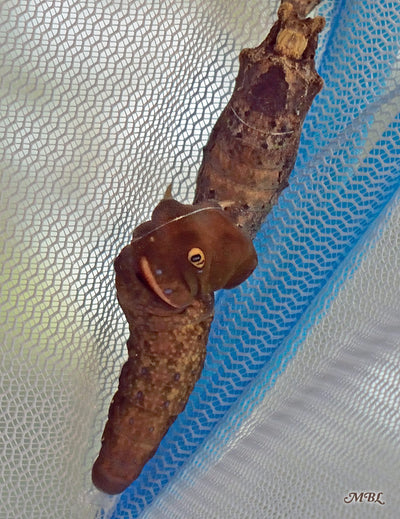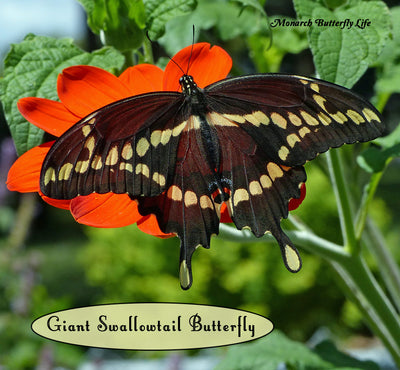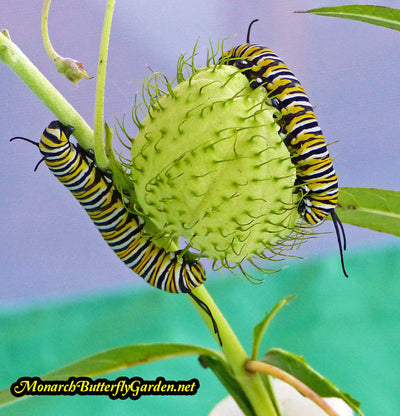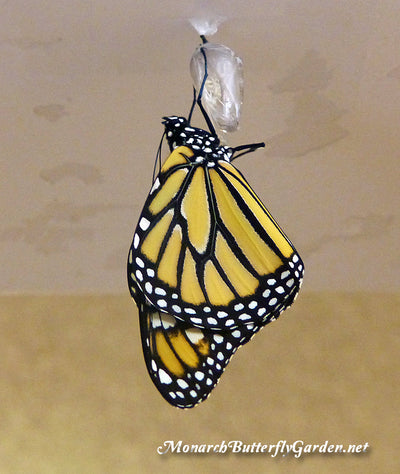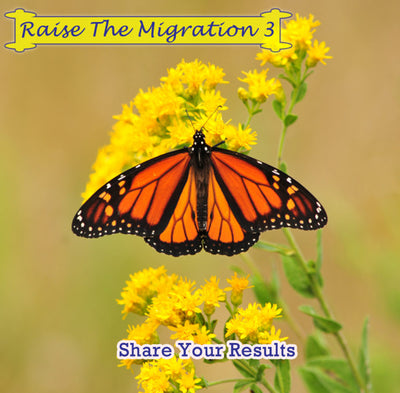Raising Butterflies Blog
How to Raise Eastern Tiger Swallowtails- Butterfly Life Cycle Photos

How To Raise Eastern Tiger Swallowtails through all 4 stages of the Butterfly Life Cycle

It all started last season, when our yard garden was taken over by a swarm of eastern tiger swallowtails (Papilio glaucus). We always have a few wander in over the season, but last July something spectacular happened. We had about eight tiger swallowtails hanging out in our garden in July and part of August…every day!
They were very friendly and often followed us around as we were tending to the butterfly garden. They liked many of the same nectar flowers as the monarchs, but their home base was the Mexican sunflowers.
Earlier that spring, we had added two chokecherry trees in hopes of hosting some of their eggs and baby caterpillars. After that amazing season, I was determined to offer them more options to entice them to stay.
Unlike milkweed-obsessed monarchs, the eastern tiger swallowtail will lay eggs on a wide range of host plants. Their butterfly life cycle also takes up to 2 months, so the odds are stacked against northern gardeners wanting to raise them with fewer generations and more plants to search!
We didn’t have enough space to add full-grown trees, so we stuck with some smaller host options. We planted a waferash tree, a slow-grower that tops out at 20 feet. We also planted a black cherry tree…in a container!
If you’re interested in learning more about (or purchasing) tiger swallowtail host plants, get more info on my butterfly plants page
Our summer of tigers was continued with record numbers next spring. I was hopeful that our new host plant additions would catch their attention…
Eastern Tiger Swallowtail Eggs
On May 13th I was planting in our garden. I looked up and a large tiger female almost flew right into me.
 A Springtime Swallowtail Makes an Unexpected Visit
A Springtime Swallowtail Makes an Unexpected VisitWe had just bought our new host plants 3 days before, and they had not been permanently planted. That meant there just one in-ground option to check for eggs…our chokecherry trees!
I looked at the first tree, which had fading blooms, and noticed there were lots of potential predators (e.g. ants, spiders) crawling around. The second tree was a few feet away and would not bloom this spring. There were no predators crawling around, but I came across 3 curiously camouflaged circles on separate leaves…
 Sweet Spring Surprise
Sweet Spring SurpriseI consulted mother google to confirm my greatest hopes, and I was ready to raise!
Other host plants for eastern tiger swallowtail caterpillars include Prunus serotina (wild black cherry), Liriodendron tulipifera (tulip tree), and Magnolia virginiana (sweet bay magnolia).
Eastern Tiger Swallowtail Caterpillars
 Baby’s First Meal
Baby’s First MealThe eggs took a full week to hatch. All 3 baby caterpillars quickly darkened with white saddles across their backs. A closer look reveals the beginnings of false eyes that will become more prominent later. These false eyes are supposed to fool predators into thinking the caterpillar is actually a snake. It’s hard to believe this snaky disguise would fool very many or for very long…

When raising small monarch caterpillars, I typically wrap wet cotton and tin foil around common milkweed leaf petioles to keep the leaves fresh. This method worked horribly with wafer thin chokecherry leaves. I picked up a new raising tool and it became a cherry lifesaver! Check out floral tubes and other helpful raising tools on my Raising Resource Page
 Floral Tubes for Chokecherry Cuttings
Floral Tubes for Chokecherry CuttingsAs the tiger swallowtails continued to grow, they started to go through some major changes…what I affectionately call the awkward teenage phase. Each caterpillar starts to turn green, as the false eyes turn blue with outer orange rims. There are also small purple dots from its false eyespots down to its final pair of prolegs…zits?
 Rarrrrrrrrrrrrrrrrr!
Rarrrrrrrrrrrrrrrrr!So, if those are false eyes, you’re probably wondering what the actual eastern tiger caterpillar’s head looks like?
 Shiny Red Head
Shiny Red HeadThe changes continue as the caterpillar sheds its skin to enter the next stage of development or instar…
 Bird’s Eye View
Bird’s Eye ViewInstar 4 from a cuter angle…awwwwww
 Awwwwwwww
AwwwwwwwwIn the 5th and final instar, before forming its chrysalis, the caterpillar turns green as its white saddle has completely disappeared. It does, however, retain it’s yellow ring and purple dots.

Instar five caterpillars finally start to show some serious growth:

The Chrysalides (or Chrysalises)
When the caterpillar coloration starts to resemble a UPS truck, you’ll know the next phase of caterpillar transformation is about to begin…
 Howdy Ho!
Howdy Ho!Shortly after the caterpillar turns brown, it purges out undigested food. Many are alarmed when they see this and think the caterpillar is sick. Don’t worry, it’s what the cat needs to do before taking things to the next level of metamorphosis.
 Blaaaaaaarrrrggghhhhhhh
BlaaaaaaarrrrggghhhhhhhI had thought I was being smart by putting a stick inside the cage for them to form their chrysalides on. My plan was to remove the stick after all four had pupated so I could have the cage back for raising monarchs. Only one complied…

The remaining three caterpillars formed a conga line on the upper corner of their mesh caterpillar cage:

The third caterpillar then proceeded to attach himself to the bottom of the second chrysalis…
 The PERFECT Place to Form a Chrysalis?
The PERFECT Place to Form a Chrysalis?Close quarters isn’t necessarily a problem, but keep in mind they can stay in chrysalis for for weeks, or even months. So, if you’re concerned about chrysalis placement or just want your cage back sooner, here’s a solution to solve all your chrysalis problems
A monarch chrysalis will hatch reliably in 7-10 days, but the swallowtail family is on their own schedule. They can take 2-3 weeks, or longer if they see fit. If you’re raising toward the end of the season, they may even decide to overwinter until next season.
Since my raising adventure started in early spring, all four butterflies eclosed by mid-July. The fifth caterpillar fell from a chokecherry cutting while attempting to molt (shed its skin). It was a small caterpillar and did not recover from the fall.
4 Eastern Tigers raised later in the season, will overwinter as chrysalides in our 3-season porch. They won’t hatch until next spring…
Eastern Tiger Swallowtail Butterflies
The first two that emerged from their chrysalides were males. I let each one sun dry outside in the mesh cage for a couple hours, and then released them. They were magnificent and both had strong wings!
Having the chrysalises bunched together was not an issue, as each butterfly emerged on a different day.


After the males were successfully released came two big surprises! The last two butterflies were female, but they were not your typical eastern tiger swallowtail female…they were both dark form!
It is believed that dark form tiger swallowtails are a defense mechanism against potential predators like birds. The dark form females are supposed to mimic the poisonous pipevine swallowtail, which can make some predators sick….

Both females were also healthy and the final female took a rest on our butterfly bush before disappearing up high into the trees. Raising the eastern tiger swallowtail butterfly was a truly fantastic experience we hope to continue next season…I hope you can too!

Would you like to start raising eastern tiger swallowtails through all 4 stages of the butterfly life cycle? Click here for butterfly cages and helpful raising supplies.
Happy Raising!


